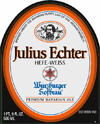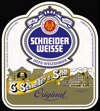Wheaten Brewing
Wheat remained an essential ingredient in central Europe well into the first millennium, as brewing became relatively modernized by European monks, whose well-honed beer was considered the best. The monastic brewers of Germany and Bohemia recognized the extraordinary qualities of hops as early as the eighth century. Bavarian Benedictine monks of Weihenstephan described their hop gardens in documents at that time.
As secular brewing operations sprouted in Germany during the second millennium, many of them continued to brew wheat beers, which were often referred to as weissebier (white beer) because of their pale, cloudy appearance. They were distinctly different from their counterparts, sometimes made at the same brewery, known as rotbier (red beer), presumably the forerunners of dark lagers and altbier. The famous beers of Einbeck employed one-third wheat and relatively lightly-kilned barley, and they were considered the finest in all of Europe. They are also ancestral bock beers. Austrian and Dutch brewers were also adept at making wheat beers.
Though wheat beers may have been an ordinary quaff of the commoners throughout central Europe in the 1400s, this was not the case in the duchy of Bavaria. The noble Degenberger clan was the sole legal producer of weissebier. Other brewers would need their permission. When the Degenberger lineage passed, the licensing of wheat beer brewing was passed to the Bavarian house of dukes.
In an historic moment, the dukes Wilhelm IV and Ludwig X of the royal House of Wittlesbach introduced the Reinheitsgetbot Purity Law in 1516. The law stated that only barley malt, hops and water could be used to make beer. While on the surface the law appears to be a protective decree to preserve the quality of beer in Bavaria, the dukes had other motives. They controlled barley farming and wanted to ascertain their stake in this monopoly, but also, this ensured that the highly coveted weissbier would only be brewed under their direction, and mostly for their own consumption. This no doubt gave common brewers a push to perfect their barley beers (probably brown ales and lagers), but also separated wheat beers as a distinctly different entity.
This royal stranglehold lasted until the 1850s, when a weissebier brewery was commissioned to expert Munich brewer, Georg Schneider. He brewed first at the Weisse Hofbräuhaus, and later at Tal near the city’s main square. He then expanded into a second brewery in Kelheim in 1872, in the midst of the Hallertau hop growing area, as a private brewery. Weissebier was no longer under the royal thumb: it had gone mainstream.
This event coincided with the rise in popularity of Munich helles lagerbiers, but Schneider held on ever so tenuously to his market, and then saw a renewed interest in wheat beers following WWII. The popularity is keen, even 60 some years later.















